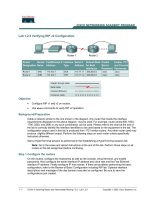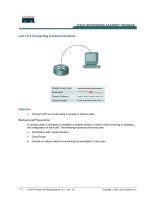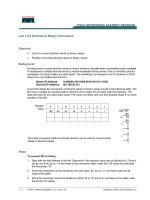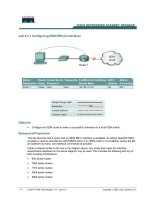Tài liệu Lab 11.2.3d Multiple Access Lists Functions (Challenge Lab) pdf
Bạn đang xem bản rút gọn của tài liệu. Xem và tải ngay bản đầy đủ của tài liệu tại đây (186.39 KB, 8 trang )
1 - 8 CCNA 2: Routers and Routing Basics v 3.0 - Lab 11.2.3d Copyright 2003, Cisco Systems, Inc.
Lab 11.2.3d Multiple Access Lists Functions (Challenge Lab)
Router
Name
Router
Type
FA0
Address
FA1
Address
S0
Address
S1
Address
Subnet
mask
Routing
Enable
password
VTY
password
2 - 8 CCNA 2: Routers and Routing Basics v 3.0 - Lab 11.2.3d Copyright 2003, Cisco Systems, Inc.
Host IP Address Subnet Mask Gateway
Objective
Configure and apply an extended access control list to control Internet traffic using one or more
routers.
Scenario
The company has a regional office (Boaz) that provides services to two branch offices (Gaston and
Centre). These offices each have a branch manager and several people responsible for providing
customer services. There has been a significant amount of turnover by the service personnel. After a
security audit, it was discovered that there are no network restrictions on the computers used by the
service personnel.
The network infrastructure team leader wants a plan created and implemented to enforce network
security to prevent access.
Infrastructure
Host #3 represents the Internet. An alternative is to use loopback 0 interface on Boaz and issue the
Boaz(config)#ip http server command.
Host #4 represents an internal web server that has sensitive personnel and payroll information.
Host #4 will also represent the network administration computer
The lowest 4 host address in each subnet are all reserved for the branch mangers’ computers (hosts
1 & 5).
The router interfaces use highest addresses in the subnets.
The remaining address in each branch’s subnet are to be used for the service personnel’s’
computers (hosts 2 & 6).
Step 1 Basic Router Interconnection
a. Interconnect the routers as shown in the diagram.
Step 2 Internetwork Address Design
a. Using a private class C IP address for the internal network, design and document the network.
Complete the preceding charts and include the interface type and number, IP address, subnet
3 - 8 CCNA 2: Routers and Routing Basics v 3.0 - Lab 11.2.3d Copyright 2003, Cisco Systems, Inc.
mask, and cable type. The “Internet” (cloud) network can be any private space address. Be sure
that the address ranges assigned to the routers and hosts meet the criteria described in the
infrastructure section above.
Step 3 Basic Router Configuration
a. The router may contain configurations from a previous use. For this reason, erase the startup
configuration and reload the router to remove any residual configurations. Using the information
previously created, setup the router configurations using RIP or IGRP and verify reachablilty by
pinging all systems and routers from each system.
To simulate specific locations on the Internet, add the following configuration to the Boaz router.
Boaz(config)#interface loopback 1
Boaz(config-if)#ip address 192.168.255.1 255.255.255.255
Boaz(config-if)#exit
Boaz(config)#interface loopback 2
Boaz(config-if)#ip address 192.168.255.2 255.255.255.255
Boaz(config-if)#exit
Boaz(config)#interface loopback 3
Boaz(config-if)#ip address 192.168.255.3 255.255.255.255
Boaz(config-if)#exit
Boaz(config)#interface loopback 4
Boaz(config-if)#ip address 192.168.255.4 255.255.255.255
Boaz(config-if)#exit
Boaz(config)#interface loopback 5
Boaz(config-if)#ip address 192.168.255.5 255.255.255.255
Boaz(config-if)#exit
Boaz(config)#interface loopback 6
Boaz(config-if)#ip address 192.168.255.6 255.255.255.255
Boaz(config-if)#exit
Boaz(config)#interface loopback 7
Boaz(config-if)#ip address 192.168.255.7 255.255.255.255
Boaz(config-if)#exit
Boaz(config)#interface loopback 8
Boaz(config-if)#ip address 192.168.255.8 255.255.255.255
Boaz(config-if)#exit
Boaz(config)#interface loopback 9
Boaz(config-if)#ip address 192.168.255.9 255.255.255.255
Boaz(config-if)#exit
Boaz(config)#interface loopback 10
Boaz(config-if)#ip address 192.168.255.10 255.255.255.255
Boaz(config-if)#exit
Add a network statement to the Boaz routing protocol to advertise this network.
Boaz(config-router)#network 192.168.255.0
Step 4 Client Configurations
a. Configure the hosts with the appropriate information using the information previously defined.
[ ] Verify reachablilty by pinging all systems and routers from each system.
b. On hosts 3 and 4 install and configure a Web server such as Tiny Web server.
( />) (Host 3 to represent the Internet. Host 4 to represent
internal web server that has sensitive personnel and payroll information.) (Host 4 can be the
Loopback of the Boaz router)
4 - 8 CCNA 2: Routers and Routing Basics v 3.0 - Lab 11.2.3d Copyright 2003, Cisco Systems, Inc.
[ ] Verify that all systems can use a web browser to access the web pages of both the intranet
server (host 4) and the Internet server (host 3).
c. On host 3, install and configure a telnet server such as TelnetXQ
( />).
[ ] Verify that all systems can Telnet to the Internet (host 3).
d. Now that the infrastructure is in place, it is time to begin securing the internetwork.
Step 5 Secure the Intranet Server
a. Host #4 represents an internal web server that has sensitive personnel and payroll information.
The information on this server should be accessible ONLY by the branch managers. Access
control list(s) should be created to secure this server so that only branch managers’ machines
have web access (http protocol) to this internal server
How many access control lists will be used? ______________________________________________
Where will the access control list(s) will be applied? _______________________________________
Which direction will the access control list(s) will be applied? _______________________________
For what reasons might it be better to use multiple access control lists?
_____________________________________________________________________________________
_____________________________________________________________________________________
For what reasons might it be better to use a single access control lists?
_____________________________________________________________________________________
_____________________________________________________________________________________
b. Using a text editor, such as Notepad, construct the logic of the access list(s) and then type the
proper commands. When the list is properly constructed, paste it in the route(s) and apply it to
the appropriate interfaces.
c. Confirm that the ACL is functioning properly:
[ ] Verify reachability by pinging all systems and routers from each system.
[ ] Verify that all computers systems can use a web browser to access the web pages on the
Internet (any where except internal web server).
[ ] Verify that the service personnel computers CANNOT use a web browser to access (http
protocol) the intranet server.
[ ] Verify that the computers from the Internet (host 3) CANNOT use a web browser to access
(http protocol) the intranet server.
Step 6 Secure the Intranet Documents
a. There is concern that internal policy and procedures documents are being shared outside of the
company. To ensure that users in the internetwork cannot forward these documents, do not
allow any computers telnet nor FTP access to the Internet.
Will new access control list(s) be created or will the current list(s) be modified?
_____________________________________________________________________________________
If new list(s):
How many new access control lists will be created? _______________________________________
Where will the new access control list(s) will be applied?
_____________________________________________________________________________________
5 - 8 CCNA 2: Routers and Routing Basics v 3.0 - Lab 11.2.3d Copyright 2003, Cisco Systems, Inc.
Which direction will the new access control list(s) will be applied?
_____________________________________________________________________________________
b. Again, use a text editor, such as Notepad, to construct the logic of the access list(s) and then
type the proper commands. When the list is properly constructed, paste it to the router(s) and
apply it to the appropriate interfaces.
c. Confirm that the ACL is functioning properly:
[ ] Verify reachability by pinging all systems and routers from each system.
[ ] Verify that all computers systems can use a web browser to access the web pages on the
Internet (any where except internal web server)
[ ] Verify that the service personnel computers CANNOT use a web browser to access (http
protocol) the intranet server
[ ] Verify computers from the Internet (host 3) CANNOT use a web browser to access (http
protocol) the intranet server
[ ] Verify that the computers CANNOT telnet to the Internet (host 3 and loopbacks interfaces on
Boaz) but can telnet to the routers
Step 7 Deter Internet Abuse
a. There have also been some complaints that employees have been abusing Internet access.
They have been accessing sites with questionable content. To help stop this practice, do not
allow any IP traffic from the internetwork to the following sites:
192.168.255.1
192.168.255.4
192.168.255.8
192.168.255.9
Will new access control list(s) be created or will the current list(s) be modified?
_____________________________________________________________________________________
If new list(s):
How many new access control lists will be created?
_____________________________________________________________________________________
Where will the new access control list(s) will be applied?
_____________________________________________________________________________________
Which direction will the new access control list(s) will be applied?
_____________________________________________________________________________________
b. Again, use a text editor, such as Notepad, to construct the logic of the access list(s) and then
type the proper commands. When the list is properly constructed, paste it to the router(s) and
apply it to the appropriate interfaces.
c. Confirm that the ACL is functioning properly:
[ ] Verify service personnel computers CANNOT use a web browser to access (http protocol) the
intranet server.
[ ] Verify that the computers from the Internet (host 3) CANNOT use a web browser to access
(http protocol) the intranet server.
[ ] Verify that the computers CANNOT telnet Internet (host 3 and loopbacks interfaces on Boaz)
but can telnet to routers.
6 - 8 CCNA 2: Routers and Routing Basics v 3.0 - Lab 11.2.3d Copyright 2003, Cisco Systems, Inc.
[ ] Verify that the computers CANNOT telnet, use a web browser to access, nor ping
192.168.255.1.
[ ] Verify that the computers CANNOT telnet, use a web browser to access, nor ping
192.168.255.4.
[ ] Verify that the computers CANNOT telnet, use a web browser to access, nor ping
192.168.255.8.
[ ] Verify that the computers CANNOT telnet, use a web browser to access, nor ping
192.168.255.9.
[ ] Verify reachability by pinging all other systems and routers from each system.
[ ] Verify all computers systems can use a web browser to access the other web pages on the
Internet (host 3 and loopbacks interfaces on Boaz).
Step 8 Deter Denial of Service (DoS) Attacks
a. In the last few weeks the company’s internetwork has been the subject to numerous denial of
service attacks. Most have taken the form of sending “Ping of Death” (oversized ICMP echo
packets) or directed broadcasts (x.x.x.255). To help stop the ”Ping of Death” attacks, do not
allow any ICMP echo packets into the internetwork. Also to stop the directed broadcast, stop all
IP packets from entering the internetwork addressed to the directed broadcast address.
Will new access control list(s) be created or will the current list(s) be modified?
_____________________________________________________________________________________
If new list(s):
How many new access control lists will be created?
_____________________________________________________________________________________
Where will the new access control list(s) will be applied?
_____________________________________________________________________________________
Which direction will the new access control list(s) will be applied?
_____________________________________________________________________________________
b. Again, use a text editor, such as Notepad, to construct the logic of the access list(s) and then
type the proper commands. When the list is properly constructed, paste it to the router(s) and
apply it to the appropriate interfaces.
c. Confirm that the ACL is functioning properly:
[ ] Verify service personnel computers CANNOT use a web browser to access (http protocol) the
intranet server.
[ ] Verify that the computers from the Internet (host 3) CANNOT use a web browser to access
(http protocol) the intranet server.
[ ] Verify that the computers CANNOT telnet Internet (host 3 and loopbacks interfaces on Boaz)
but can telnet to routers.
[ ] Verify that the computers CANNOT telnet, use a web browser to access, nor ping
192.168.255.1.
[ ] Verify that the computers CANNOT telnet, use a web browser to access, nor ping
192.168.255.4.
[ ] Verify that the computers CANNOT telnet, use a web browser to access, nor ping
192.168.255.8.
[ ] Verify that the computers CANNOT telnet, use a web browser to access, nor ping
192.168.255.9.
7 - 8 CCNA 2: Routers and Routing Basics v 3.0 - Lab 11.2.3d Copyright 2003, Cisco Systems, Inc.
[ ] Verify that all computers systems can use a web browser to access the other web pages on
the Internet (host 3 and loopbacks other interfaces on Boaz).
[ ] Verify that host 3 CANNOT successfully ping anything in the internetwork.
[ ] Verify that the systems can successfully ping to the other internet hosts.
[ ] Verify reachability by pinging all other systems and routers from each system.
Step 9 Stop Telnet into the Routers
a. There have also been some attempts to telnet into the routers from both inside and outside the
internetwork. The only host that should have telnet access to the routers is the network
administration computer. To stop telnet access to the routers create an access control list and
apply it to the VTY lines of the routers that will permit only the network administration computer
to telnet.
What type of access list will be used?
_____________________________________________________________________________________
What command will be used to apply the list to the VTY lines?
_____________________________________________________________________________________
b. Use a text editor, such as Notepad, to construct the logic of the access list(s) and then type the
proper commands. When the list is properly constructed, paste it to the router(s) and apply it to
the VTY lines.
c. Confirm that the ACL is functioning properly:
[ ] Verify that the service personnels’ computers CANNOT use a web browser to access (http
protocol) the intranet server.
[ ] Verify that the computers from the Internet (host 3) CANNOT use a web browser to access
(http protocol) the intranet server.
[ ] Verify that the computers CANNOT telnet Internet (host 3 and loopbacks interfaces on Boaz)
but can telnet to routers.
[ ] Verify that the computers CANNOT telnet, use a web browser to access, nor ping
192.168.255.1.
[ ] Verify that the computers CANNOT telnet, use a web browser to access, nor ping
192.168.255.4.
[ ] Verify that the computers CANNOT telnet, use a web browser to access, nor ping
192.168.255.8.
[ ] Verify that the computers CANNOT telnet, use a web browser to access, nor ping
192.168.255.9.
[ ] Verify that all computers systems can use a web browser to access the other web pages on
the Internet (host 3 and loopbacks other interfaces on Boaz).
[ ] Verify that host 3 CANNOT successfully ping anything in the internetwork.
[ ] Verify that systems can successfully ping to the other internet hosts.
[ ] Verify that systems can successfully ping host 3.
[ ] Verify that the network administration computer (host 4) can telnet to all of the routers.
[ ] Verify that other internal computers CANNOT telnet to any of the routers.
[ ] Verify that other external computers (host 3) CANNOT telnet to any of the routers.
8 - 8 CCNA 2: Routers and Routing Basics v 3.0 - Lab 11.2.3d Copyright 2003, Cisco Systems, Inc.
Step 10 Verify the Access Lists
a. Now that the access lists have been applied, they need to be verified.
First, verify what lists have been defined. From a CLI session on one of the routers with access
lists, display the access lists with the Boaz#show ip access-lists command. Record the
information about one of the access lists.
_____________________________________________________________________________________
_____________________________________________________________________________________
_____________________________________________________________________________________
_____________________________________________________________________________________
_____________________________________________________________________________________
_____________________________________________________________________________________
_____________________________________________________________________________________
What does the “(# matches)” in the output represent?
_____________________________________________________________________________________
b. Next, confirm which access list is applied to each interface. This is done from the terminal
session of one of the routers with access lists, with the Boaz#show ip interface command.
Look at the output from each interface and record the lists applied to each interface.
Interface __________
Outgoing access list is ________
Inbound access list is ________
Interface __________
Outgoing access list is ________
Inbound access list is ________
Interface __________
Outgoing access list is ________
Inbound access list is ________
Interface __________
Outgoing access list is ________
Inbound access list is ________
c. Once the lab is complete, erase the start-up configuration on routers, remove and store the
cables and adapter. Also logoff and turn the router off.









